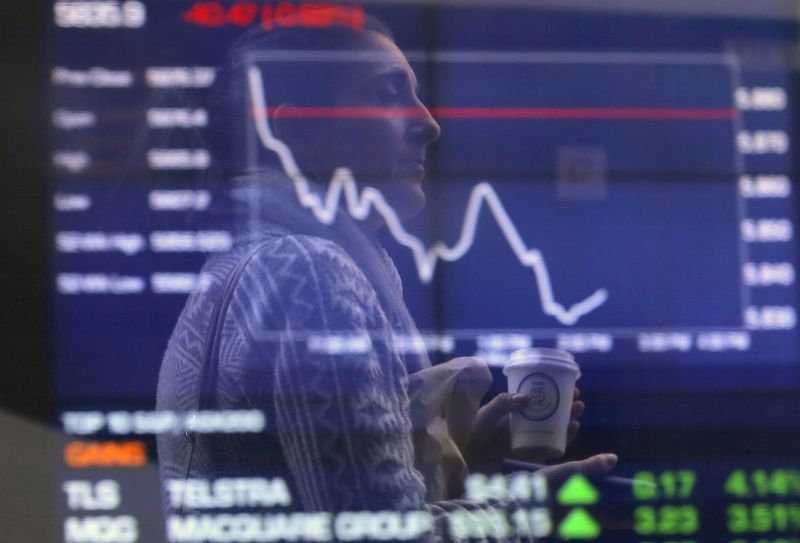The ASX is predicted to fall in opening trade, with Futures down 28 points or 0.4%. Time will tell whether the bourse will maintain that course throughout the day.
“A softer-than-expected Australian labour force report came to the aid of the beleaguered Australian stock market today, which plunged 89 points (-1.2%) shortly after the opening bell, following a weaker lead from Wall Street,” IG market analyst Tony Sycamore said.
“The fall in employment, which follows hot on the heels of Tuesday's tepid wages data, was viewed as a positive development as it provides another reason for the RBA to stay on hold in September.
“A thought that yesterday bought out dip buyers in the ASX200, currently caught in a tidal wave of renewed concerns over the Chinese economy, higher yields, and a softer Australian dollar.”
The market’s concerns over China’s flagging economic performance continued overnight, with all markets down.
Adding to the consternation, debt-struck Chinese construction company Evergrande (HK:3333) officially filed for bankruptcy in New York, causing the S&P 500 to slip 0.8% - it’s likely the downward slide will continue, as Futures point to a further 0.94% dip.
The issue was further compounded by strengthening economic data, which increased fears of sticky inflation (and thus further interest rate hikes) and helped push the markets lower.
US markets looking bearish
US jobless claims fell by 11,000 in the past week, dipping just under forecasts to reach 239,000. The Conference Board leading index fell by 0.4% in July as predicted, but the Philadelphia Fed manufacturing index rose from -13.5 in July to +12 in August, thrashing analysts’ expectations of -10.4.
“US stock indices fell for a third consecutive session as the bond bear market rout deepened,” Sycamore explained.
“Overnight yields on the US 10-year note revisited their October 2022 4.33% high, while yields on the 30-year bond traded to the highest level since 2011.
“Higher bond issuance, resilient data, the BoJ’s tweak to its YCC at the end of July and concerns that China is selling treasuries to defend its currency are the factors driving the rise in yields.
“Overnight, the Philly Fed index came in stronger than expected at 12 vs the 10.4 exp.
“We continue to think the chances of another Fed Rate hike before year-end are underpriced, a view that the rates (and equities market) are moving towards (probability of a 25bp rate hike by the Fed in November up to 44% from 22% two weeks ago).”
Shares of major US health stocks with pharmacy benefit management units fell as Blue Shield of California announced it would end its reliance on CVS Health (NYSE:CVS) (-8.1%) and work with companies like Amazon.com (NASDAQ:AMZN) instead. UnitedHealth (NYSE:UNH) and Cigna (NYSE:NYSE:CI) were caught in the crossfire, shedding 1.9% and 6.4% respectively.
Giants like Walmart (NYSE:WMT) (-2.2%), Apple (NASDAQ:AAPL) (1.5%) and Microsoft (NASDAQ:MSFT) (-1.1%) all played their part in dragging the indexes lower.
The Dow dropped 291 points or 0.8% despite being up 123 points earlier in the day, while the Nasdaq dipped 158 points or 1.2%.
European markets and commodities
European markets followed the US’s lead, falling in the face of a raft of worse-than-expected earnings reports and rising bond yields, which could keep inflation humming along for longer.
Those fears were strengthened by Norway's central bank, Norges Bank, voting to increase its key policy rate by 25 basis points to a flat 4.00%.
A big 39% collapse in Dutch payments processor Adyen (on the back of missed half-year earnings estimates) dragged the industrials index, and thus the markets, down. The industrials index fell 2.8%, the FTSEurofirst 300 index lost 0.9% and the UK FTSE100 fell by 0.6%.
Currencies were mixed against the US dollar.
- The Euro fell from to US$1.0855 and was near US$1.0870 at the US close.
- The Aussie lifted to US$0.6449 cents and was near US$0.6400 cents at the US close.
- The Japanese yen firmed to JPY145.62 and was near JPY145.80 at the US close.
Brent rose by US$0.67 or 0.8% to US$84.12 a barrel, US Nymex by US$1.01 or 1.3% to US$80.39 a barrel.
“WTI Crude Oil closed higher at $80.12 (0.93%) snapping a three-day losing streak,” Sycamore said.
“Nonetheless, following its retreat below $80.00 this week, the recent pop above $84.00 has been exposed as a false break higher, and we look for crude oil to rotate back towards the middle of its nine-month range $76.00 area in the weeks ahead.”
Base metals rose, with copper futures up 0.9% and aluminium futures rising 0.8% - iron ore also enjoyed a boost, rising by US$0.83 or 0.8% to US$105.64 a tonne.
Gold fell as economic indicators begin to normalise, shedding US$13.10 or 0.7% to US$1,915.20 an ounce.
